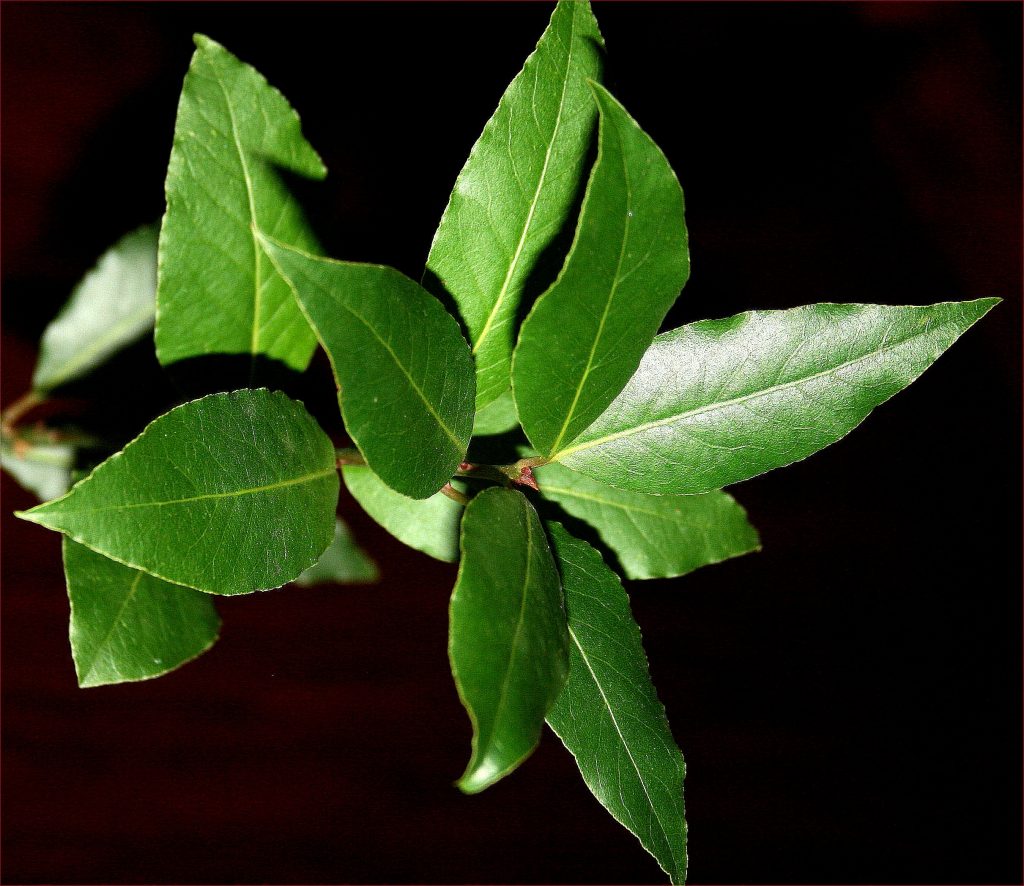
Bay leaf, or Laurus nobilis, originated in Asia Minor and spread to Mediterranean countries where it thrives because of the warm climate and continual breezes. Bay Laurel, also known as Sweet Bay, is called Alloro or Lauro in Italian.
Bay Laurel is an easy-to-grow evergreen tree whose leaves are used for cooking and medicine. This tree can remain small if root-bound and trained, 1 to 2 feet (30 to 61 cm) in height, or develop into a large hedge over 6 feet (1.8 m) tall. Requiring sunny conditions, moderate watering and breeze, this tree is hardy and not susceptible to many insects. The main pest to watch for is scale. If the tree hosts scale, it is easily removed by hand or by watering the branches, so bay laurel can live for years in your garden.
Traditions: Bay Laurel is a symbol of honor and was very important in ancient Greece and Rome. Remember seeing antique drawings of athletes wearing a crown of branches with leaves? Those were braided branches of young bay leaves. Even today, when I walk through the streets of Bologna during university graduation, the recent laureates clothed in flowing robes are wearing what on their heads? A wreath of fresh bay leaves. Charming…this honoring of ancient history. The Romans and Greeks would chew bay leaves as a breathe freshener.
Applications: Bay leaf contains lauric acid which has good insecticidal properties, and is anti-fungal and anti-bacterial. Proven effective in treating migraine headaches, bay leaf herbals contains parthenolides compounds. Bay leaf has been shown to increase insulin-production so it is useful for regulating high blood sugar. It is a good digestive that calms the intestines, counters a tired feeling, insomnia, and colds For the flu, bring water to a simmer with the leaves and inhale the steam, it helps clear the passages. All-in-all, quite an impressive herb for its medicinal value.
Bay Leaf Essential Oil: Bay leaf belongs to same Family Myrtaceae as cinnamon and camphor. The oil from the leaves and berries is used for treating a wide range of maladies including poor digestion and loss of appetite, throat and lung problems including tonsillitis and bronchitis, and infections accompanied by a fever because bay leaf oil induces sweating. For ear infections, this oil can mitigate dizziness and restore balance. Topically, bay leaf oil effectively treats bruises and strains, and is a good hair and scalp tonic. This essential oil is potent, so it is best used externally and only very small amounts taken internally.
Culinary Uses: Dried or fresh bay leaves are used to add a subtle underlying depth of flavor in many braised dishes and stews. They are especially good with game, beef, pork, rabbit, and root vegetables. Fresh bay leaves are an entirely different subject. Fortunately they are now sold in many grocery stores, and if you haven’t tasted or smelled fresh leaves, make it a point to purchase a small package of them soon. They last for months in the refrigerator, and if they dry-out, their flavor remains more intense than commercially-dried versions.
We use fresh bay leaves for many fish preparations. Stuff the fish cavity with them along with some lemon, orange, or lime slices. Grilling outdoors? Skewer cubes of fish or shellfish and place one fresh bay leaf on either side, so your skewer looks like bay leaf-fish-bay leaf-fish-bay leaf. In Sicily, we infuse extra-virgin olive oil with fresh bay leaves and pour this sauce over whole grilled fish or fish steaks. It’s delicious and the freshness of the fish shines through. Grill some thick lemon, tangerine, or orange slices while you’re at it and serve those alongside. Often bay leaf is the only herb used in fish preparations because of its predominant flavor; if you want to make the dish more complex, pair it with another assertive herb such as rosemary.
Fresh bay leaves make remarkable, delicate infusions for tisanes and digestivos. Since bay leaves are brittle and almost inedible, usually they are left whole while cooking food, and making tisanes and digestivos, then removed before serving the dish.
* This synopsis imparts valuable information that could be beneficial as part of a wellness program. Its purpose is to open the thought process to consider including herbs and spices as natural supplements in personal regimens. Briefly stating how the plant was valued and used historically in different ages and cultures, it lists some current uses. If interested in this particular plant, please extend your research via books and articles for more details and uses.
With increasing interest for including alternative therapies with standard drug therapy, research continues, so this topic evolves continuously. Please consult your wholistic and holistic practitioners, homeopaths, nutritionists, dentists, and physicians to keep yourself updated if you choose to incorporate or ingest the plant in any form for medical purposes.










